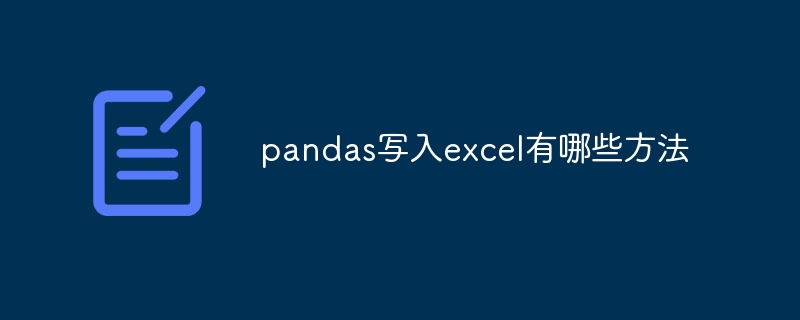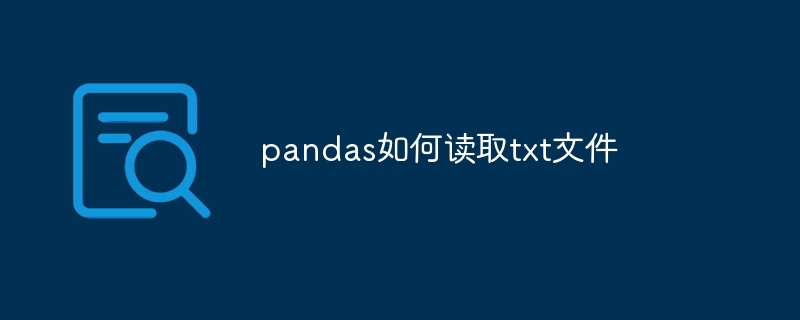
Steps and techniques for using pandas to read CSV files for data manipulation
Introduction:
In data analysis and processing, it is often necessary to read from CSV files Get the data and perform further operations and analysis. pandas is a powerful Python library that provides a set of tools for data processing and analysis, making it easy to process and manipulate CSV files. This article will introduce the steps and techniques of reading CSV files based on pandas, and provide specific code examples.
1. Import the pandas library
Before using the pandas library, you need to import the library first. We can achieve this through the following code:
import pandas as pd
2. Reading CSV files
Reading CSV files is an important function of pandas. pandas provides the read_csv() function, which can read a CSV file into a DataFrame object to facilitate subsequent data operations and analysis. The following is a basic code example for reading a CSV file:
data = pd.read_csv('file.csv')
In the above code, 'file.csv' is what you want to read The path to the CSV file. After reading, the data will be stored in a DataFrame object named data.
3. View data
After reading the CSV file, we can use the head() function to view the first few lines of the data. This is very helpful in understanding the structure of the data and the need for data cleaning. The following is a code example for viewing data:
print(data.head())
This code will output the first five rows of data in data.
4. Data processing and operation
pandas provides a wealth of functions and methods to process and operate data. Several commonly used data processing techniques will be introduced below.
4.1 Data filtering
We can use the conditional filtering function provided by pandas to quickly filter out the data we need. For example, if we want to find the data whose "city" is "Beijing" in data, we can use the following code:
filtered_data = data[data['city'] == 'Beijing']
In the above code, data['City'] == 'Beijing' returns a Boolean Series, representing whether each row of data meets the conditions. Then, we use this Boolean Series as an index to filter out the data that meets the conditions and store it in filtered_data.
4.2 Data sorting
pandas provides the sort_values() function to sort data. The following is a code example for sorting data in descending order according to the "sales" column:
sorted_data = data.sort_values(by='sales', ascending=False)
The above code will be as follows The "Sales" column sorts the data in descending order and stores the sorting results in sorted_data.
4.3 Data grouping and aggregation
pandas provides the groupby() function and agg() function, which can easily implement data grouping and aggregation operations. The following is a code example to group data by the "City" column and calculate the total sales of each city:
grouped_data = data.groupby('City').agg({'Sales':' sum'})
The above code will group the data according to the "City" column and use the agg() function to calculate the total sales of each group (city). The results will be stored in grouped_data.
5. Data output
After processing the data, we can output the data to a CSV file or other format files. Use the to_csv() function of pandas to output the DataFrame object as a CSV file. The following is a code example that outputs grouped_data as a CSV file:
grouped_data.to_csv('grouped_data.csv')
The above code outputs grouped_data as a CSV file named 'grouped_data.csv' .
Conclusion:
This article introduces the basic steps and common techniques for using pandas to read CSV files for data manipulation, and provides specific code examples. By mastering these skills, you can easily read and process CSV files and quickly perform data analysis and data operations. Using the pandas library can greatly improve the efficiency of data processing, making data analysis work more convenient and efficient.
The above is the detailed content of Data manipulation of CSV files using pandas: steps and tips. For more information, please follow other related articles on the PHP Chinese website!
 python pandas安装方法Nov 22, 2023 pm 02:33 PM
python pandas安装方法Nov 22, 2023 pm 02:33 PMpython可以通过使用pip、使用conda、从源代码、使用IDE集成的包管理工具来安装pandas。详细介绍:1、使用pip,在终端或命令提示符中运行pip install pandas命令即可安装pandas;2、使用conda,在终端或命令提示符中运行conda install pandas命令即可安装pandas;3、从源代码安装等等。
 日常工作中,Python+Pandas是否能代替Excel+VBA?May 04, 2023 am 11:37 AM
日常工作中,Python+Pandas是否能代替Excel+VBA?May 04, 2023 am 11:37 AM知乎上有个热门提问,日常工作中Python+Pandas是否能代替Excel+VBA?我的建议是,两者是互补关系,不存在谁替代谁。复杂数据分析挖掘用Python+Pandas,日常简单数据处理用Excel+VBA。从数据处理分析能力来看,Python+Pandas肯定是能取代Excel+VBA的,而且要远远比后者强大。但从便利性、传播性、市场认可度来看,Excel+VBA在职场工作上还是无法取代的。因为Excel符合绝大多数人的使用习惯,使用成本更低。就像Photoshop能修出更专业的照片,为
 如何使用Python中的Pandas按特定列合并两个CSV文件?Sep 08, 2023 pm 02:01 PM
如何使用Python中的Pandas按特定列合并两个CSV文件?Sep 08, 2023 pm 02:01 PMCSV(逗号分隔值)文件广泛用于以简单格式存储和交换数据。在许多数据处理任务中,需要基于特定列合并两个或多个CSV文件。幸运的是,这可以使用Python中的Pandas库轻松实现。在本文中,我们将学习如何使用Python中的Pandas按特定列合并两个CSV文件。什么是Pandas库?Pandas是一个用于Python信息控制和检查的开源库。它提供了用于处理结构化数据(例如表格、时间序列和多维数据)以及高性能数据结构的工具。Pandas广泛应用于金融、数据科学、机器学习和其他需要数据操作的领域。
 时间序列特征提取的Python和Pandas代码示例Apr 12, 2023 pm 05:43 PM
时间序列特征提取的Python和Pandas代码示例Apr 12, 2023 pm 05:43 PM使用Pandas和Python从时间序列数据中提取有意义的特征,包括移动平均,自相关和傅里叶变换。前言时间序列分析是理解和预测各个行业(如金融、经济、医疗保健等)趋势的强大工具。特征提取是这一过程中的关键步骤,它涉及将原始数据转换为有意义的特征,可用于训练模型进行预测和分析。在本文中,我们将探索使用Python和Pandas的时间序列特征提取技术。在深入研究特征提取之前,让我们简要回顾一下时间序列数据。时间序列数据是按时间顺序索引的数据点序列。时间序列数据的例子包括股票价格、温度测量和交通数据。
 pandas写入excel有哪些方法Nov 22, 2023 am 11:46 AM
pandas写入excel有哪些方法Nov 22, 2023 am 11:46 AMpandas写入excel的方法有:1、安装所需的库;2、读取数据集;3、写入Excel文件;4、指定工作表名称;5、格式化输出;6、自定义样式。Pandas是一个流行的Python数据分析库,提供了许多强大的数据清洗和分析功能,要将Pandas数据写入Excel文件,可以使用Pandas提供的“to_excel()”方法。
 pandas如何读取txt文件Nov 21, 2023 pm 03:54 PM
pandas如何读取txt文件Nov 21, 2023 pm 03:54 PMpandas读取txt文件的步骤:1、安装Pandas库;2、使用“read_csv”函数读取txt文件,并指定文件路径和文件分隔符;3、Pandas将数据读取为一个名为DataFrame的对象;4、如果第一行包含列名,则可以通过将header参数设置为0来指定,如果没有,则设置为None;5、如果txt文件中包含缺失值或空值,可以使用“na_values”指定这些缺失值。
 pandas怎么读取csv文件Dec 01, 2023 pm 04:18 PM
pandas怎么读取csv文件Dec 01, 2023 pm 04:18 PM读取CSV文件的方法有使用read_csv()函数、指定分隔符、指定列名、跳过行、缺失值处理、自定义数据类型等。详细介绍:1、read_csv()函数是Pandas中最常用的读取CSV文件的方法。它可以从本地文件系统或远程URL加载CSV数据,并返回一个DataFrame对象;2、指定分隔符,默认情况下,read_csv()函数将使用逗号作为CSV文件的分隔符等等。
 4000字详细说明,推荐20个好用到爆的Pandas函数方法Aug 10, 2023 pm 02:52 PM
4000字详细说明,推荐20个好用到爆的Pandas函数方法Aug 10, 2023 pm 02:52 PM今天分享几个不为人知的pandas函数,大家可能平时看到的不多,但是使用起来倒是非常的方便,也能够帮助我们数据分析人员大幅度地提高工作效率,同时也希望大家看完之后能够有所收获。


Hot AI Tools

Undresser.AI Undress
AI-powered app for creating realistic nude photos

AI Clothes Remover
Online AI tool for removing clothes from photos.

Undress AI Tool
Undress images for free

Clothoff.io
AI clothes remover

AI Hentai Generator
Generate AI Hentai for free.

Hot Article

Hot Tools

Atom editor mac version download
The most popular open source editor

mPDF
mPDF is a PHP library that can generate PDF files from UTF-8 encoded HTML. The original author, Ian Back, wrote mPDF to output PDF files "on the fly" from his website and handle different languages. It is slower than original scripts like HTML2FPDF and produces larger files when using Unicode fonts, but supports CSS styles etc. and has a lot of enhancements. Supports almost all languages, including RTL (Arabic and Hebrew) and CJK (Chinese, Japanese and Korean). Supports nested block-level elements (such as P, DIV),

SublimeText3 Linux new version
SublimeText3 Linux latest version

VSCode Windows 64-bit Download
A free and powerful IDE editor launched by Microsoft

ZendStudio 13.5.1 Mac
Powerful PHP integrated development environment






